Living here the last few years, I’ve come to realize just how lacking my knowledge is of California native plant species. I’m trying hard to educate myself as much as I can, but every once in a while, just as with the Calochortus we found here, I encounter a plant whose identity eludes me for a while.
In early spring I found this remarkable set of leaves growing at the base of a slope here on the property.
This plant was keeping the company of Redwood Sorrel, and Trillium, lurking in the shade behind one of our Coast Live Oaks.
The leaves seemed almost tropical in appearance, and reminded me somewhat of the leaves of my long since dead Phalaenopsis orchids. (I really have very brown thumbs when it comes to growing orchids).
There was a small cluster of flower buds on a narrow stalk in the center of the plant, but I had absolutely no idea what this plant was. I’d never encountered anything quite like it. Without the plant in bloom though, it was difficult to make a positive identification.
After some rummaging around in books and on-line sources, it seemed this plant was most likely Clintonia, but I still wasn’t certain. Then on our visit to the San Francisco Flower & Garden Show at the end of March, at the Bay Natives Nursery booth, there was a small, identical looking plant, also not blooming, labeled as Clintonia andrewsiana sitting on a shelf in a pot…but I almost fainted when I saw the price. $50 for a 1 gallon plant!
Feeling a little smug that such a lovely, and rather pricey native plant seemed to have volunteered itself on our east facing slope, I couldn’t wait for it to bloom! So in the meantime I did a little research to see what I could learn about it.
Clintonia andrewsiana is native to coastal California, and only found from Monterey county California to southwestern Oregon, primarily in shaded mixed redwood forest. Although according to the Bureau of Land Management, there is apparently some debate as to whether this plant has been extirpated from Oregon.
This plant typically has 4-5 basal leaves, although our particular specimen is quite large, with 7 leaves. The single flowering stem ranges from 25-50 cm tall, and sports a showy pink to deep red terminal cluster of flowers between May and July, with up to four supplemental flower clusters borne laterally along the stem.
More than two months after first finding this plant growing here, the flowers finally began to open…
It’s clear that the flowers on our plant are more toward the pink end of the spectrum for this species.
Following the flowers, stunning cobalt-blue fruits appear in summer.
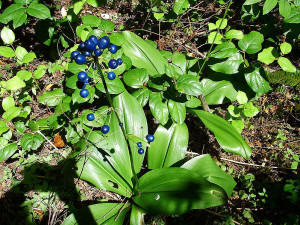
The blue bead-like fruits of Clintonia andrewsiana (Public Domain Image from the National Park Service)
Thus far, this is the only plant I’ve found, although it’s quite possible there are more that I’ve missed. It’s certainly not abundant, although I’d love for more of these to grow here, but clearly, as expensive as they are, I either need to be patient and see if more grow on their own, or try germinating them from seed. Apparently ‘deer relish the flowers and berries’. This plant is currently not protected from the deer on the property, so it’s quite remarkable it has survived long enough to bloom.
The real question is, will it survive to set seed? I’m seriously considering fencing this plant off, to afford it the best opportunity to set seed.
If I succeed in gathering seed from this plant, it apparently is best sown in humus rich soil, after cleaning the pulp from the seed. Much like Trillium though, propagating this plant from seed requires tremendous patience, as it apparently takes four to seven years for Clintonia andrewisana to reach blooming size once sown.
I was curious to see if Native Americans had any specific uses for Clintonia andrewsiana, but I only found that the Pomo and Kashaya tribes considered this plant to be poisonous [1].
————————
*The specific epithet ‘andrewsiana’ commemorates the 19th Century English botanical artist, Henry Charles Andrews.
[1] Daniel E. Moerman’s Native American Ethnobotanical Database




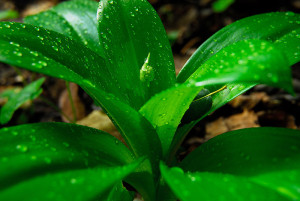




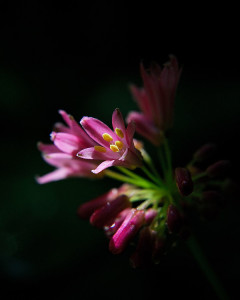
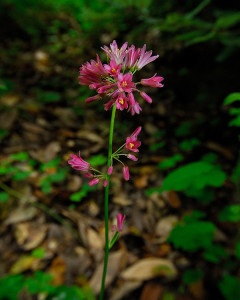
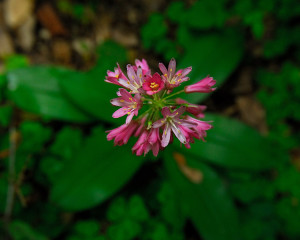
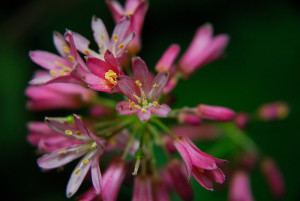







Lovely dramatic photos of the Clintonia andrewsiana
Will the berries really be that blue? Show us, if you get any.
.-= Elephant’s Eye´s last blog ..My Yellows =-.
They really are supposed to be that blue. I’m curious though to see how blue they look in person. If the deer don’t eat them, I promise to post a photo when ours sets fruit.
what a gorgeous plant. I wonder if the extra rains this year is what brought it out. I remember going to Death Valley during our last El Nino and the wildflower bloom was spectacular. They also had plants show up that no one had seen in 30+ years.
.-= Dog Island Farm´s last blog ..Monday’s Guests- Tea Towel To Apron =-.
I think the rain this winter and spring have helped a number of plants bloom more this year. Our Trilliums were more prolific, and our Calcochortus bloomed for the first time (that we noticed) since we moved here. I suppose it’s also possible that this plant is just finally old enough to flower. It’s a great shame that so many of our lovely native plants take so long to go from seed to bloom. I think that’s all the more reason to protect them.
Cool. The flowers are different but the berries could pass for each other. Around here we have Yellow Clintonia (borealis)but the berries are still that vibrant blue – Bluebead Lily
.-= wiseace´s last blog ..A peek at my garden =-.
You know a good plant when you see one! $50.00 geeez…
Beautiful photographs!
.-= Amy/GoAway, I’m Gardening!´s last blog ..Sunny With A Chance of Gardening =-.
Clare, This is very interesting. We have a wildflower Clintonia here in New England called the “Blue Bead Lily.” It has the same amazing blue berries (Yes, Diana, they really are that blue!), but a very shy green flower.
.-= Jean´s last blog ..An Early Spring: GBBD, May 2010 =-.
I admire how you take so much interest in the environment around you and strive to learn about all of the native plants around you.
.-= Noelle / azplantlady´s last blog ..May’s MGB…..Monthly Garden Bouquet =-.
It is very pretty and you are so lucky to have it growing on your property, given the pricey tag on the plant at the flower show.
.-= melanie´s last blog ..Home Again =-.
It really is pretty! I’m always surprised at how much nurseries charge for native plants. I hope you’re able to try collecting the seed. What a great find!
.-= Catherine´s last blog ..The pond in May. =-.
GREAT find, and what a pretty plant!I don’t know the native plants either…learning as I go!
.-= kimberly´s last blog ..Quick Update, Mouse & Trowel and Heliconia Sale! =-.
I would fence it off considering what a little treasure it is in beauty and in monetary value and then collect the seeds.
.-= Rosie@leavesnbloom´s last blog ..It started with a Plum Royale =-.
You always give such good and full information about plants. This one is pretty! The leaves do look almost tropical!
.-= Tatyana´s last blog ..Touch Of Formality In My Garden (Garden Elements. Part 2) =-.
Clare, Another terrific post! I always learn so much visiting you! When I first saw the lovely green leaves of your Clintonia andrewsiana … I thought … Oh, I hope the deer do not eat those! Then later in the post you noted they loved it! How lucky to have the flower!! And what a flower! So striking!! Beautiful photos and those berries are equal to the beauty of the flowers. Good luck with protecting it and getting some seeds!
.-= Carol´s last blog ..Lightness of Being Amongst Wings in a Garden =-.
What an absolutely beautiful and rare find! I, too, am often shocked by the high prices that some of our native plants command in the retail nursery market. Consequently, I’ve been trying my hand at propagating natives from seed or stem cuttings. So far, I’ve had some success with Bush Monkeyflowers (Diplacus spp.) and Manzanitas, as long as the cuttings are taken & planted in late fall or early winter. I do hope to see more photos of the natives species from your site.
.-= Camissonia´s last blog ..Mas Que Nada and a Hodgepodge of Garden Tasks =-.